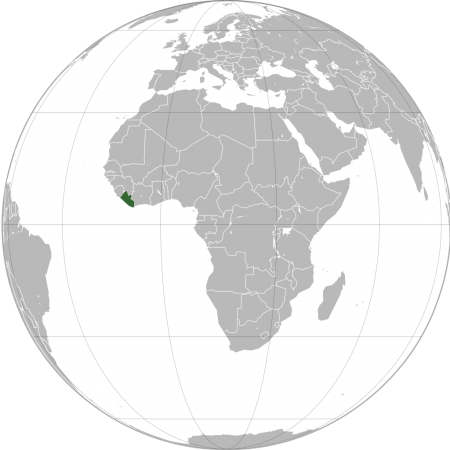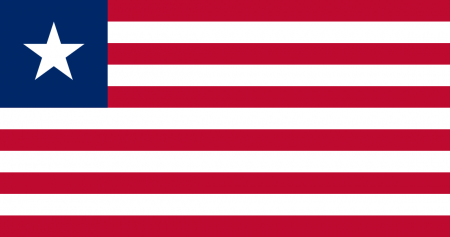Area: 111,369 sq. km. (43,000 sq. mi.) (slightly larger than Ohio)
Cities: Capital–Monrovia (est. 1,000,000).
Principal towns: Buchanan (est. 300,000), Ganta (est. 290,000), Gbarnga (est. 150,000), Kakata (est. 100,000), Harbel (est. 136,000).
Terrain: Three areas–Mangrove swamps and beaches along the coast, wooded hills and semideciduous shrublands along the immediate interior, and dense tropical forests and plateaus in the interior. Liberia has 40% of West Africa’s rain forest.
People
Nationality: Noun and adjective–Liberian(s).Population (2004): 3.4 million.Annual growth rate (2004): 2.4%.Ethnic groups: Kpelle 20%, Bassa 16%, Gio 8%, Kru 7%, 49% spread over 12 other ethnic groups.Religions: Christian 40%, Muslim 20%, animist 40%.Languages: English is the official language. There are 16 indigenous languages.Education: Literacy (2003)–20%.Health: Life expectancy (2003)–47 years.Work force: Agriculture–70%; industry–15%; services–2%.
There are 16 ethnic groups that make up Liberia’s indigenous population. The Kpelle in central and western Liberia is the largest ethnic group. Americo-Liberians who are descendants of freed slaves that arrived in Liberia early in 1821 make up an estimated 5% of the population.
There also are sizable numbers of Lebanese, Indians, and other West African nationals who make up a significant part of Liberia’s business community. The Liberian constitution restricts citizenship only to people of Negro descent; also, land ownership is restricted by law to citizens.
Liberia was traditionally noted for its hospitality and academic institutions, iron mining and rubber industry booms, and cultural skills and arts and craft works. But political upheavals beginning in the 1980s and the brutal 14-year civil war (1989-2003) brought about a steep decline in the living standards of the country, including its education and infrastructure.
Government
Type of government: Republic. Independence: From American Colonization Society July 26, 1847.Constitution: January 6, 1986.Political parties: 30 registered political parties
Liberia has a bicameral legislature consisting of 66 representatives and 30 senators. Historically, the executive branch heavily influences the legislature and judicial system, the latter being largely dysfunctional for now.
There is a Supreme Court, criminal courts, and appeals court and magistrate courts in the counties. There also are traditional courts and lay courts in the counties. Trial by ordeal is practiced in various parts of Liberia. Locally, political power emanates from traditional chiefs (town, clan, or paramount chiefs), mayors, and district commissioners. Mayors are elected in principal cities in Liberia. Superintendents appointed by the president govern the counties. There are 15 counties in Liberia.
Economy
GDP (IMF 2005 est.): $548.4million.Real GDP growth rate (2004): 2.0%.Per capita GDP (2005): $119.4.Consumer Price Index (2004): 7.0%.Natural resources: Iron ore, rubber, timber, diamonds, gold and tin. The Government of Liberia has reported in recent years that it has discovered sizable deposits of crude oil along its Atlantic Coast.Agriculture: Products–coffee, cocoa, sugarcane, rice, cassava, palm oil, bananas, plantains, citrus, pineapple, sweet potatoes, corn, and vegetables.Industry: Types–agriculture, iron ore, rubber, forestry, diamonds, gold, beverages, construction. Trade (2004): Exports–$103.8 million: rubber 93%; cocoa 3.5%. Major markets–Germany, Poland, U.S., Greece. Imports–$268.1 million: mineral fuels and lubricants; food and live animals; machinery and transport equipment; manufactured goods; pharmaceuticals; and tobacco.
The Liberian economy relied heavily on the mining of iron ore and on the export of natural rubber prior to the civil war. Liberia was a major exporter of iron ore on the world market. In the 1970s and 1980s, iron mining accounted for more than half of Liberia’s export earnings. Following the coup d’etat of 1980, the country’s economic growth rate slowed down because of a decline in the demand for iron ore on the world market and political upheavals in Liberia. Liberia’s foreign debt amounts to about $3.5 billion.
The 1989-2003 civil war had a devastating effect on the country’s economy. Most major businesses were destroyed or heavily damaged, and most foreign investors and businesses left the country.
As the second-largest maritime licenser in the world–with more than 1,800 vessels registered under its flag, including 35% of the world’s tanker fleet–Liberia earns some $14 million annually from the flag registry. There is increasing interest in the possibility of commercially exploitable offshore crude oil deposits along Liberia’s Atlantic Coast.
Liberia’s business sector is largely controlled by foreigners, mainly of Lebanese and Indian descent. There also are limited numbers of Chinese engaged in agriculture. There also are significant numbers of West Africans engaged in cross-border trade.
Liberia is a member of ECOWAS. With Guinea and Sierra Leone, it formed the Mano River Union (MRU) for development and the promotion of regional economic integration. The MRU became all but defunct because of the Liberian civil war, which spilled over into neighboring Sierra Leone and Guinea. There was some revival of MRU political and security cooperation discussions in 2002.
With a new, democratically elected government in place since January 2006, Liberia seeks to reconstruct its shattered economy. The Governance and Economic Management Program (GEMAP), which started under the 2003-2006 transitional government, is designed to help the Liberian Government raise and spend revenues in an efficient, transparent way. Success under GEMAP and solid economic performance should result in Liberia being able to attract investment and begin rebuilding its economy.
Current Economy
The Liberian economy had relied heavily on the mining of iron ore prior to the civil war. Liberia was a major exporter of iron ore on the world market. In the 1970s and 1980s, iron mining accounted for more than half of Liberia's export earnings. Since the coup d'état of 1980, the country's economic growth rate has slowed down because of a decline in the demand for iron ore on the world market and political upheavals in Liberia. Liberia's foreign debt amounts to more than $3 billion.
Timber and rubber are Liberia's main export items since the end of the war. Liberia earns more than $100 million and more than $70 million annually from timber and rubber exports, respectively. Alluvial diamond and gold mining activities also account for some economic activity.
Being the second-largest maritime licenser in the world with more than 1,700 vessels registered under its flag, including 35% of the world's tanker fleet, Liberia earned more than $18 million from its maritime program in 2000. The Liberian Government has declared in recent months that it has discovered sizable amounts of crude oil along its Atlantic coast.
Liberia's business sector is largely controlled by foreigners mainly of Lebanese and Indian descent. There also are limited numbers of Chinese engaged in agriculture. The largest timber concession, Oriental Timber Corporation (OTC), is Indonesian owned. There also are significant numbers of West Africans engaged in cross-border trade.Liberia is a member of the Economic Community of West African States (ECOWAS). With Guinea and Sierra Leone, it formed the Mano River Union (MRU) for development and the promotion of regional economic integration. The MRU became all but defunct because of the Liberian civil war which spilled over into neighboring Sierra Leone and Guinea.
Liberia has relied heavily on vast amounts of foreign assistance, particularly from the United States, Japan, Britain, France, Italy, Germany, the People's Republic of China, and Romania. But because of the Liberian Government's perceived disregard for human rights, foreign assistance to Liberia has declined drastically. The Republic of China (Taiwan) and Libya are currently the largest donors of direct financial aid to the Liberian Government. However, significant amounts of aid continue to come in from Western countries through international aid agencies and non-governmental organizations, avoiding direct aid to the government.
The United Nations imposed sanctions on Liberia in May 2001 for its support to the rebels of the Revolutionary United Front (RUF) in neighboring Sierra Leone.Unlike almost all other countries in the world, Liberia has not adopted the metric system as its primary system of measurement.In March 2010, Bob Johnson, founder of BET, funded the first hotel constructed in Liberia in 20 years. The 13-acre (53,000 m2) luxury resort was built in the Paynesville section of Monrovia.
Foreign Relations
Liberia has maintained traditionally cordial relations with the West. China and Libya have been prominent international partners in Liberia's reconstruction. Liberia also maintains diplomatic relations with Cuba.
Liberia is a founding member of the United Nations and its specialized agencies and is a member of the African Union (AU), the Economic Community of West African States (ECOWAS), the African Development Bank (ADB), the Mano River Union (MRU), and the Non-Aligned Movement.Liberia has taken steps to forge closer ties with Western countries, especially the United States. President Ellen Johnson Sirleaf has visited several Western countries, including the United Kingdom, Sweden, Norway, Spain, France, and Germany. President Johnson Sirleaf has also visited China and Libya.
The political impasse in Cote d’Ivoire over the November 28, 2010 presidential elections prompted more than 140,000 people to cross into Liberia as refugees. They inhabit the border region and belong to rival ethnic groups generally perceived as having supported either the legitimately elected president, Alassane Ouattara, or former president Laurent Gbagbo. Although the Ivoirian political stalemate has since been resolved, the humanitarian crisis affecting both the refugees and the receiving communities has lingered. Liberia’s coordination of, and support for, international relief efforts has been welcome.
U.S.- Liberia Relations
Congress appropriated $100,000 in 1819 for the establishment of Liberia (and resettlement of freemen and freed slaves from North America) by the American Colonization Society, led by prominent Americans such as Francis Scott Key, George Washington's nephew Bushrod, Henry Clay, Daniel Webster, and Presidents Monroe (for whom Liberian settlers named the capital, Monrovia), Adams, and Jackson. The first group of settlers arrived in Liberia from the United States in the 1820s. The United States, which officially recognized Liberia in 1862, shared particularly close relations with Liberia during the Cold War.
The outbreak of civil war in Liberia and the long dominance of Charles Taylor soured bilateral relations. However, Liberia now counts the United States as its strongest supporter in its democratization and reconstruction efforts. Since the end of Liberia's civil war in 2003, the United States has contributed over $1 billion in bilateral assistance and more than $1 billion in assessed contributions to the UN Mission in Liberia (UNMIL). In February 2008, President George W. Bush visited Liberia, where he held his fourth one-on-one meeting with President Johnson Sirleaf since her inauguration in January 2006. Peace Corps volunteers returned to Liberia in 2008 for the first time since 1990. Secretary of State Hillary Clinton paid an official visit to Liberia in August 2009. President Johnson Sirleaf met President Barack Obama and Secretary Clinton in Washington in May 2010.
In Monrovia, the U.S. Agency for International Development (USAID) implements its second-largest development program in Africa. USAID's post-conflict rebuilding strategy focuses on reintegration and is increasingly moving toward a longer-term development focus. Rehabilitation efforts include national and community infrastructure projects, such as expanding access to electricity, building roads, refurbishing government buildings, training Liberians in vocational skills, promoting business development, and improving livelihoods while protecting Liberia's forests. USAID also funds basic education programs, improving education for children, focusing on girls, and training teachers. USAID programs also include primary health care clinics, HIV/AIDS prevention, and a large malaria program. Further, USAID supports rule of law programs, establishing legal aid clinics and victim abuse centers, training judges and lawyers, community peace building and reconciliation efforts, and anti-corruption projects to promote transparency and accountability in public sector entities. USAID is also providing support to strengthen the legislative and other political processes, and is strengthening civil society's role in delivering services and advocating good governance. U.S. bilateral assistance totaled almost $230 million in FY 2010. In July 2010, the Government of Liberia signed a $15 million Threshold Program with the Millennium Challenge Corporation to strengthen indicators in land reform, girl’s education, and trade.






